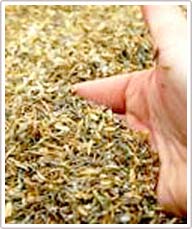Fabrication of insulation from rice husk
A Malaysian scientist said she has discovered a low-cost way to turn rice husk (waste of rice production) into a high-tech material that could help reduce electricity bills and protect buildings in bombings and make aircraft lighter.
Aerog - the lightest solid known to man - was invented in 1931 by an American scientist, but only
 High production costs have limited the use of this material. Professor Halimaton Hamdan of the University of Technology in Malaysia said that the process she was working on could cut production costs to 80% of Aerogel, making it a widely used popular material. The Malaysian government said it would donate $ 62.5 million to a large-scale pilot project of Professor Hamdan. She said the cost of making 100 grams of airgel according to her rice husk use process only costs 60 USD compared to 300 USD if using the current methods.
High production costs have limited the use of this material. Professor Halimaton Hamdan of the University of Technology in Malaysia said that the process she was working on could cut production costs to 80% of Aerogel, making it a widely used popular material. The Malaysian government said it would donate $ 62.5 million to a large-scale pilot project of Professor Hamdan. She said the cost of making 100 grams of airgel according to her rice husk use process only costs 60 USD compared to 300 USD if using the current methods.
One of the applications of airgel is to cover the walls, greatly reducing the need for heating and air conditioning systems. Aerogel's insulation capacity is 37 times more efficient than glass fiber. In addition, Aerogel can withstand 2,000 times its weight, making it a suitable material to produce bulletproof doors and soundproofing materials. This material also features cleaning up oil spills on the sea and sucking pollutants in the air.
Currently, Professor Hamdan's method is still in the experimental stage and it will take several years for her airgel production technique to be commercialized.
- Press rice husk into high quality fuel
- Successful production of rice husk firewood
- Technology to produce tires from rice husk ash
- Rice husk is a clean construction material
- Philippines: Gas stove is made of environmentally friendly rice husk
- Clean water filter device from rice husk
- Vietnamese scientist finds the inhibitor of invasive weeds from rice husk
- Technology to turn rice husk into ... wood
- High quality fuel from rice husk
- Vietnam produces fireproof and bulletproof paints made from rice husk
- Use rice husks to produce electric batteries
- White rice and brown rice, which is more nutritious?
 'Barefoot engineer' invents a pipeless pump
'Barefoot engineer' invents a pipeless pump Process of handling dead pigs due to disease
Process of handling dead pigs due to disease Radiometer
Radiometer Warp Engine: Technology brings us closer to the speed of light
Warp Engine: Technology brings us closer to the speed of light